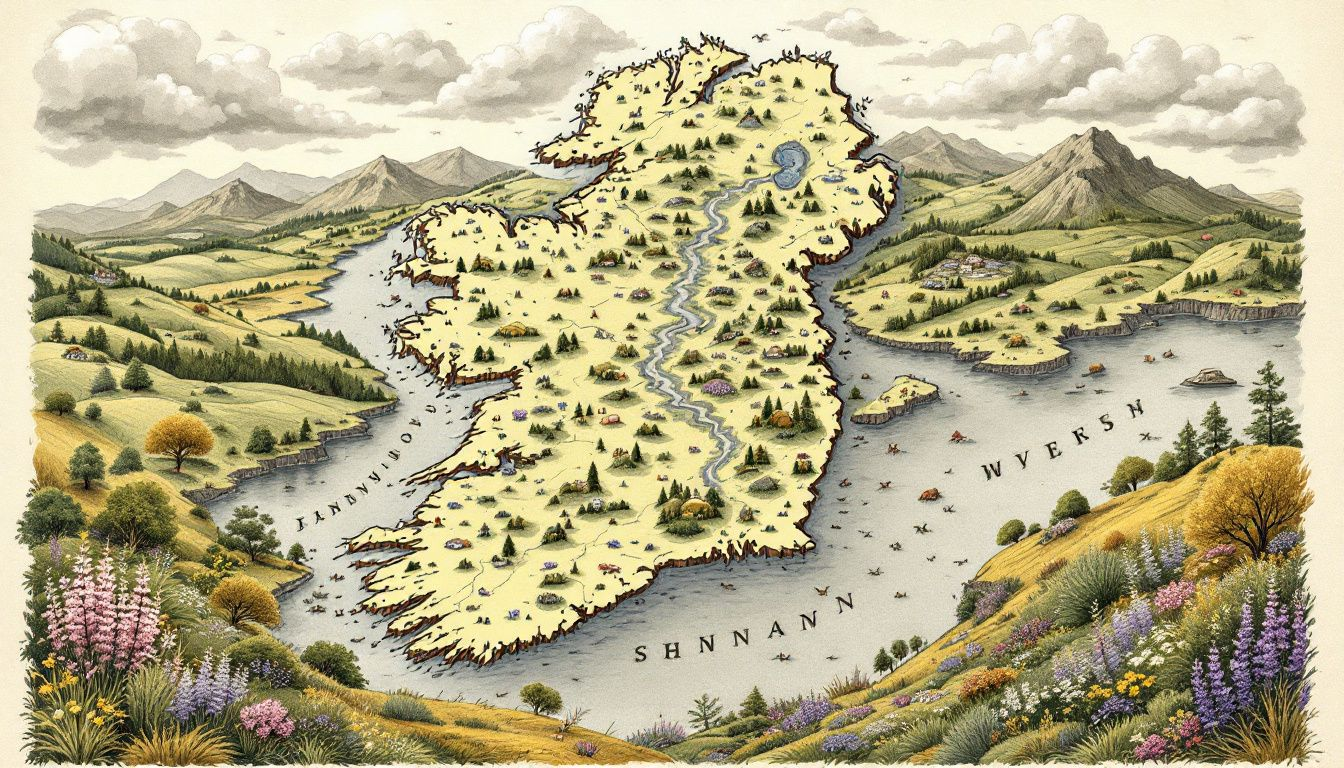Planning a trip to Ireland and wondering about the weather? Find out what to expect with our month-by-month guide to the weather by month in Ireland. This comprehensive overview will help you prepare for any season, whether you’re visiting for travel or curious about the climate.
Key Takeaways
Ireland experiences a temperate maritime climate with distinct seasonal weather patterns that significantly impact temperatures, precipitation, and wind across the year.
Monthly weather variations highlight temperature ranges from cold winters averaging around 5°C in January to warm summers exceeding 20°C in July, affecting travel and daily activities.
Regional differences in weather are pronounced, with western areas receiving higher rainfall compared to the drier eastern regions, influencing local climates and outdoor planning.
Monthly Weather Overview in Ireland

Ireland’s weather is a symphony of diverse patterns, influenced by its geographical location and the Atlantic Ocean. Each month brings its own unique climate, affecting everything from daily activities to travel plans. Grasping these monthly weather changes helps anyone planning to explore or reside in Ireland. Dublin, Shannon, and Sligo serve as representative locations to compare the average weather across the country, offering a snapshot of what one might expect in different regions.
Ireland experiences a temperate maritime climate, characterized by mild temperatures year-round. However, each month has its distinct weather patterns that can significantly impact your plans. From the cold and sometimes snowy January to the sunny and warm July, this overview provides a month-by-month guide to Ireland’s weather, helping you prepare for any conditions.
January Weather in Ireland
January is often the coldest month in Ireland, with average temperatures hovering around 5.5°C (41.9°F), and lows dropping to about 3°C (32°F). Dublin, in particular, experiences average low temperatures around 39°F, making it a chilly start to the year. The northern parts of Ireland, including Northern Ireland, are not immune to cold northerly winds, contributing to the overall cool climate.
Heavy rain and the occasional snowfall add to January’s wintry mix, so dressing warmly and preparing for variable weather is advisable.
February Weather in Ireland
February continues the winter chill with temperatures ranging from 3°C to 8°C (37°F to 46°F). The presence of cold northerly winds can make it feel even colder, especially in Northern Ireland. Despite being a short month, February’s weather is quite similar to January, with a mix of cold days and occasional clear spells.
You might still need your winter coat, but signs of spring’s gradual warming start to appear.
March Weather in Ireland
March marks the beginning of spring in Ireland, bringing a mix of sunny spells and rainy days. Average temperatures can be mild but variable, reflecting the transition from winter to spring. The average rainfall in March typically hovers around 70 mm, indicating a considerable amount of precipitation.
March blends the remnants of winter with the first hints of warmer days, offering an interesting time to witness Ireland’s changing seasons.
April Weather in Ireland
April sees a noticeable rise in temperatures, with daily averages between 7.9°C and 9.3°C. The average water temperature also begins to increase, reaching around 50°F.
This month is often a prelude to the warmer months ahead, with longer daylight hours and occasional clear skies. April is a great time to start exploring the outdoors as the weather becomes more inviting.
May Weather in Ireland
May is a month of transition into warmer weather in Ireland, with average temperatures between 10°C and 16°C (50°F to 61°F). Sunnier afternoons make for pleasant outdoor activities. However, May can still experience varying levels of precipitation, typical for spring weather in Ireland.
It’s a time when Ireland starts to bloom, making it a picturesque month to visit.
June Weather in Ireland
June is among the warmest months, with maximum temperatures averaging 66°F to 70°F. Numerous sunny days and extended clear skies, especially later in the month, are common.
Despite the warmth, June averages 2.5 to 3 inches of rainfall, indicating a moderate chance of rain. The increasing water temperature, around 54°F, also makes it a good time for coastal activities.
July Weather in Ireland
July is usually the warmest month, with temperatures often exceeding 17°C. Average temperatures range from 12°C to 22°C (54°F to 72°F), marking the peak of summer. Dublin experiences an average high temperature of 67°F, making it the warmest month of the year.
This is the best time to enjoy outdoor activities and festivals, taking full advantage of Ireland’s summer.
August Weather in Ireland
August maintains summer warmth with average highs around 20°C (68°F), similar to July, but with an increased chance of rain, expecting around 12 days of precipitation.
This month often experiences both sunny and wet days, making it a time of clear spells interspersed with rain. It’s a month of mixed weather, but still warm enough to enjoy Ireland’s natural beauty.
September Weather in Ireland
September marks the transition into autumn, bringing cooler temperatures across Ireland. The average water temperature is around 60°F, and daylight hours start to decrease, affecting the overall sunshine hours. Wet days become more frequent as autumn sets in, marking a month of changing weather patterns.
It’s a beautiful time to witness the autumn foliage and enjoy the crisp air.
October Weather in Ireland
October features a noticeable drop in temperature, averaging between 8°C and 14°C (46°F to 57°F), and typically more rainy days compared to previous months. Winds can also increase, further affecting the feel of the decreasing temperatures.
October is a time when Ireland fully embraces autumn, with vibrant colors and cooler weather.
November Weather in Ireland
November continues the trend of colder temperatures, averaging around 7.1°C to 8.8°C, and often sees frequent rainfall, maintaining its reputation as a wet month. With temperatures ranging from 5°C to 10°C (41°F to 50°F), November is one of the colder months, signaling the approach of winter.
It’s a time to bundle up and enjoy the cozy indoor activities Ireland has to offer.
December Weather in Ireland
December in Ireland typically features colder temperatures, hovering between 3°C and 7°C (37°F to 45°F). There is an increased chance of wintry showers, especially towards the end of the month.
The cool climate sets the stage for winter, making December a festive yet chilly time.
Regional Weather Variations in Ireland

Ireland’s climate is heavily influenced by its geographical features and proximity to the Atlantic Ocean. This results in significant regional variations in weather patterns. The western regions, for instance, experience higher volumes of rainfall due to Atlantic frontal systems, while the eastern regions tend to be slightly drier. Recognizing these regional differences aids in planning activities and travel within Ireland.
Oceanic climates and geographical features combine to create distinct weather variability across Ireland’s regions. Dublin, Shannon, and Sligo offer a snapshot of these variations, with each location experiencing unique weather patterns. From the higher rainfall in the west to the clearer skies in the east, Ireland’s regional weather variations add to the country’s diverse climate.
Dublin Weather Patterns
Dublin’s weather varies throughout the year, with distinct monthly differences in temperature, precipitation, and wind speeds. In January, for instance, Dublin enjoys clear skies about 35% of the time, providing a mix of cold and clear weather.
Dublin’s weather features a blend of sunny spells, occasional heavy rain, and moderate temperatures throughout the year.
Shannon Weather Patterns
Shannon’s weather is slightly warmer than the national average, with July being the warmest month, reaching up to 67°F. Heavy rainfall is common in western Ireland, and Shannon experiences significant precipitation levels.
In January, Shannon sees clear conditions about 31% of the time, highlighting the variability in weather patterns.
Sligo Weather Patterns
Sligo, influenced by its coastal location, experiences relatively high levels of rainfall and moderate temperatures. With a 29% chance of clear skies in January, Sligo’s weather is a mix of rain and clear spells throughout the year. The coastal climate significantly impacts Sligo’s weather, making it a wetter region compared to others.
Northern Ireland Weather Forecast
Northern Ireland has mild temperatures and significant rainfall, especially from autumn to winter. The average high temperature during July hovers around 66°F, indicating a milder summer compared to other regions.
The frequent rainfall impacts temperature perception, making Northern Ireland’s climate distinct from the east coast.
Seasonal Weather Trends in Ireland

Ireland experiences distinct seasonal changes that significantly affect its weather patterns throughout the year. Each season offers unique characteristics, from cold, sometimes harsh winters to mild, blooming springs. Recognizing these seasonal trends aids in planning activities and appreciating Ireland’s natural beauty year-round.
Spring and summer are typically the driest seasons, averaging around 260 mm of rainfall, while autumn and winter bring increased precipitation levels. The temperate maritime climate, influenced by prevailing winds from the Atlantic Ocean, ensures mild temperatures year-round, but each season has its own charm and challenges.
Winter Weather in Ireland
Winter in Ireland is characterized by temperatures ranging from 4.0°C to 7.6°C. Dublin’s average winter temperatures hover around 5°C (41°F), while the north coast averages about 3°C in January. Heavy rain events are common, often leading to substantial rainfall accumulation and localized flooding.
Occasional snow and frost, especially in higher regions, add to the wintry feel, so preparing for cold and wet weather is advisable.
Spring Weather in Ireland
Spring in Ireland features a gradual warming trend, with temperatures usually ranging from 8°C to 13°C. April marks a significant increase in temperatures, often reaching daily highs of around 10°C. A mix of sunny spells and rain, along with blooming wildflowers, makes spring beautiful and lively.
The increase in daylight hours also allows for more outdoor activities in the afternoon, making it a pleasant time to explore Ireland.
Summer Weather in Ireland
Summer in Ireland usually sees average maximum temperatures ranging from 16°C to 20°C (61°F to 68°F). Recent years have seen particularly warm spells, with average summer temperatures increasing significantly. The north coast experiences slightly cooler summer temperatures, around 15°C.
Summer is when Ireland has the most clear days, offering ample opportunities for outdoor activities and festivals.
Autumn Weather in Ireland
Autumn in Ireland features temperatures beginning to cool, often dropping below 10°C as the season progresses. September brings milder weather, with average temperatures between 12°C and 18°C (54°F to 64°F). Increased wind patterns and frequent rainfall characterize this season, particularly in late September and October.
Vibrant autumn foliage and crisp air make it a picturesque time to visit, despite cooler and wetter conditions.
Average Temperature Data Across Ireland

Ireland typically experiences mild temperatures year-round, with average highs and lows varying by season. The temperate climate is characterized by mild, moist conditions with significant rainfall and minimal temperature extremes. The average annual temperature in Ireland typically ranges between 9°C and 10.5°C, making it a country with relatively stable and moderate weather.
Recognizing average temperature data aids in planning activities and travel. From cooler winters averaging around 5°C to warmer summers reaching up to 20°C, Ireland’s climate offers gentle variation year-round. This consistency makes Ireland a comfortable destination for visitors and residents alike.
Temperature Data for Major Cities
Major cities like Dublin and Shannon offer a glimpse into Ireland’s temperature variations. Dublin’s average highs range from 8°C in January to 20°C in July, reflecting typical seasonal changes. Shannon’s average annual temperatures are slightly warmer, at around 10.8°C.
June often has the highest average temperatures, reaching up to 14.6°C, while July is generally the warmest month, with highs around 19°C.
North Coast Temperature Trends
The north coast of Ireland, including Northern Ireland, shows distinct temperature trends. January and February are the coldest months, with average temperatures dipping significantly. March brings a slight increase in temperatures, but it remains relatively cool as winter transitions to spring.
Warmer periods occur during summer, especially in July and August, when temperatures can peak.
Temperature Changes Over Time
In recent decades, Ireland has seen a noticeable increase in average temperatures, especially during spring and summer. Winter temperatures have shown less variability, indicating a stable warming trend. In the last five years, average summer temperatures have risen by approximately 1.5 degrees Celsius compared to previous decades.
Projections indicate that if current trends continue, Ireland could see an additional increase in average temperatures of up to 2 degrees Celsius by 2040.
Precipitation and Rainfall Patterns in Ireland

Ireland’s climate is synonymous with frequent rainfall, significantly influenced by Atlantic frontal systems. The average annual rainfall varies across the country, with eastern regions receiving between 750 to 1,000 mm, while western areas can exceed 1,250 mm. The combination of oceanic influences and geographical features results in substantial regional differences in precipitation levels. Recognizing these patterns aids in planning activities and travel in Ireland.
Heavy rain is common in autumn and winter, contributing to high precipitation levels. For instance, January sees average precipitation of about 99.4 mm, making it one of the wetter months. The wettest areas, particularly mountainous regions, can experience more than 3,000 mm of annual rainfall due to significant orographic rainfall.
Monthly Rainfall Averages
Monthly rainfall averages in Ireland vary significantly, with October often exceeding 100 mm of rainfall, making it the wettest month. November sees the most precipitation in Northern Ireland. Sligo averages 15.8 rainy days in January, making it the wettest month for the region.
In Shannon, December usually has the highest precipitation, averaging around 3.6 inches of rain.
Heavy Rain and Showers
Heavy rain is particularly intense during autumn and winter. October typically receives the most rainfall, while April is usually the driest month. Rainfall varies across regions, with the west coast experiencing more rain than the east coast.
Orographic rainfall in mountainous areas leads to significantly higher precipitation levels than in other regions.
Wet Days vs. Dry Days
Dublin typically has around 130-150 rainy days each year, mostly featuring light to moderate rain. The weather in Dublin is characterized by a mix of wet and dry days, reflecting the typical Irish climate.
This mix of wet and dry days is common across Ireland, with regional variations shaping the overall weather experience.
Wind and Sunshine in Ireland
Wind and sunshine play crucial roles in Ireland’s weather patterns. May marks the beginning of warmer weather, with up to 7-8 hours of sunshine per day. Sunshine hours impact outdoor activities and the overall climate perception, making it an important aspect of Ireland’s weather. Recognizing wind speeds and sunshine hours aids in planning daily activities and enjoying Ireland’s natural beauty.
Average wind speeds vary across regions; for instance, Dublin averages 17.0 mph in January. Sligo typically sees 16.8 mph winds in January, while February averages around 20 km/h, contributing to cooler conditions. These wind patterns, along with sunshine hours, significantly influence Ireland’s weather experience.
Average Wind Speeds
Dublin averages wind speeds of 17.0 mph in January, marking a windy start to the year. Sligo also sees significant wind activity, with typical speeds of 16.8 mph in January.
February’s average wind speeds of around 20 km/h contribute to cooler conditions, especially with cold northerly winds.
Hours of Daylight
Daylight hours in Ireland vary throughout the year due to seasonal changes. March sees an increase in daily sunlight, averaging 4-5 hours per day.
In Dublin, daylight can reach up to 17.0 hours during peak summer, allowing ample time for outdoor activities. Shannon averages 7.5 hours of daylight, reflecting the gradual increase as spring progresses.
Clear Spells and Sunny Days
Clear spells and sunny days significantly impact Ireland’s climate and weather patterns. March typically sees more sunny days than February, signifying a shift in weather as Ireland transitions to spring.
These clear spells and sunny days make the Irish landscape even more beautiful, providing perfect opportunities for outdoor activities and exploration.
Summary
In summary, Ireland’s weather is a complex but fascinating subject, characterized by its temperate maritime climate and significant regional variations. From the cold and sometimes snowy winters to the warm and sunny summers, understanding these patterns helps in planning activities and making the most of what Ireland has to offer. Whether you’re navigating the rainy days of autumn or enjoying the clear spells of spring, Ireland’s weather is an integral part of its charm. Embrace the unpredictability, and you’ll find that every season in Ireland has its own unique beauty.
Frequently Asked Questions
What is the weather like in Ireland in January?
January in Ireland is generally cold, with average temperatures around 5.5°C (41.9°F) and a significant likelihood of heavy rain and snow.
How often does it rain in Dublin?
Dublin experiences approximately 130 to 150 rainy days annually, with rainfall primarily being light to moderate. Therefore, one should be prepared for frequent precipitation throughout the year.
What is the warmest month in Ireland?
July is typically the warmest month in Ireland, with average high temperatures often reaching up to 22°C (72°F).
How does the weather vary across different regions in Ireland?
Weather in Ireland varies significantly due to its geographical features and oceanic influences, with the western regions experiencing higher rainfall compared to the slightly drier eastern areas. Understanding these regional differences is essential for planning activities.
What are the average wind speeds in Ireland?
The average wind speeds in Ireland typically range around 16.8 to 17.0 mph in winter months like January. Overall, wind speeds tend to vary across the country, with some places experiencing averages of about 20 km/h.


